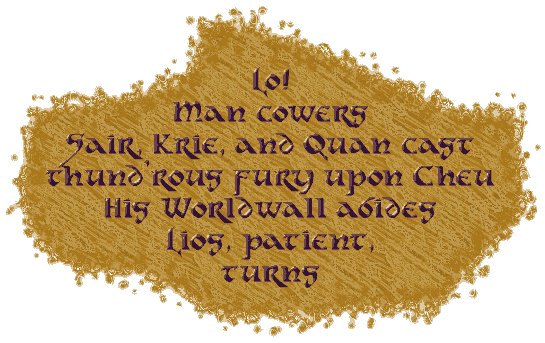
Thus reads Felsulla's pareut entitled Gods at the Edge of the World during the third century of the Empire, when its extents reached out to those kingdoms now collectively known as the North Marches. And thus The Worldwall remains to this day in the seventh century of the Empire. Neither Sair’s winds, Quan’s rains, nor Krie’s lightnings have wrought any damage upon Cheu’s Worldwall.
Centuries ago, at a triple conjunction of the full moons, the world was convulsed in a destructive upheaval known as The Rivening. On this night, which only the most ancient of Elves hold in their reveries, it seemed the end of all things: the green face of the largest moon, Liycc, joined the smaller faces of Nawm and tiny Thremm. Many lands were thrown beneath the waves; others rose from the seabed. Others were even said to have been flung into the heavens as strange, winged ships fled the world. Spires and veils of indestructible Earthbone sprang from the ground.
Along the northern edge of what was to become the Empire, a vast palisade of Earthbone hundreds of miles long thrust forth from the ground to reach a mile skyward. It has come to be called The Worldwall. Its parchment-pale flanks and colonnades run, unbroken and unscalable, for hundreds of leagues from the Kessid, the great eastern sea, to the great central massif of Cheuguai sai Elendi, the Vault of the Gods.
Of the world before this time, little is known save what few histories may be found the ruins of the great halls and castles of that time, now buried under the ash of time. In the Rivening, the great cities were cast into ruin and buried. Few were those who survived, and fewer still were those knowledgeable of the histories of the age preceding. Minstrels and Bards sing the legends and myths of swords of might, crowns and sceptres imbued with the forces of good and evil, law and chaos, or the balance of them. Other lays tell of great deeds, both for good and ill, but these likely are merely the pinnacle, the most-remembered accomplishments of that other age.

